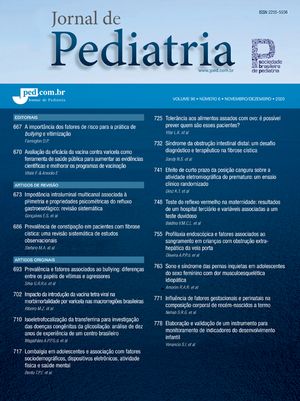
To present the diagnostic criteria of genital ambiguity, the initial medical management and the attitude expected of pediatricians.
SourcesReview of the scientific literature in the form of articles indexed on MEDLINE, in English and Portuguese, published between 1990 and 2007 and dealing with the pediatric age group.
Summary of the findingsPediatricians have a fundamental role to play in the assessment of genital ambiguity, the purpose of which is to arrive at an etiologic diagnosis in the shortest possible time in order to define the patient's sex and plan treatment. There are specific diagnostic criteria, but, in general, genitalia are ambiguous whenever there is difficulty in attributing gender to a child. The pediatrician should inform the patient's family that assignment of their child's sex will depend upon detailed laboratory investigations, preferably carried out by a multidisciplinary team at a tertiary service. The 46,XX or 46,XŸ karyotypes are not alone sufficient to define the gender of rearing, although the test is fundamental to guide the investigation. When there are no palpable gonads, the first hypothesis should be congenital adrenal hyperplasia. Other causes included partial androgen insensitivity, 5α-reductase deficiency, partial gonadal dysgenesis and hermaphroditism. The family should be provided with support and information throughout the assessment process, and their participation is fundamental in the decision of which gender to rear the child in.
ConclusionsAlthough cases of genital ambiguity are relatively rare for pediatricians, they should be well-informed on the subject and the correct management of these conditions, since they will often be responsible for the initial guidance that families receive and for maintaining contact between them and the multidisciplinary team.
Apresentar os critérios diagnósticos de ambigüidade genital, a conduta médica inicial e a postura esperada do pediatra.
Fontes dos dadosRevisão de literatura científica por meio de artigos publicados no MEDLINE nos idiomas inglês e português, no período de 1990 a 2007 e na faixa etária pediátrica.
Síntese dos dadosO pediatra tem papel fundamental na avaliação da ambigüidade genital, cujo objetivo é obter diagnóstico etiológico preciso no menor tempo possível para definição do sexo e estabelecimento dos procedimentos terapêuticos. Há critérios diagnósticos específicos, porém, de modo geral, uma genitália é ambígua sempre que houver dificuldade para se atribuir o sexo à criança. O pediatra deve informar à família que a definição do sexo dependerá de investigação laboratorial minuciosa, feita preferencialmente por equipe interdisciplinar em serviço terciário. O cariótipo 46,XX ou 46,XŸ não é suficiente para definir o sexo de criação, porém esse exame é fundamental para direcionar a investigação. Quando não houver gônadas palpáveis, a primeira hipótese deve ser hiperplasia adrenal congênita. Entre as outras causas, estão insensibilidade parcial a andrógenos, deficiência da enzima 5α-redutase, disgenesia gonadal parcial e hermafroditismo. A família deve receber apoio e informações durante todo o processo de avaliação, e sua participação é fundamental na decisão sobre o sexo de criação.
ConclusõesEmbora casos de ambigüidade genital sejam relativamente raros para o pediatra, este deve estar informado sobre o tema e a conduta adequada a tomar, pois freqüentemente será o responsável pela orientação inicial da família e pela ligação entre esta e a equipe interdisciplinar.








